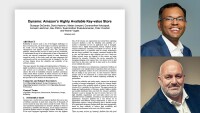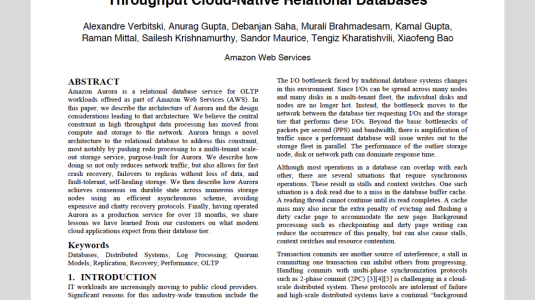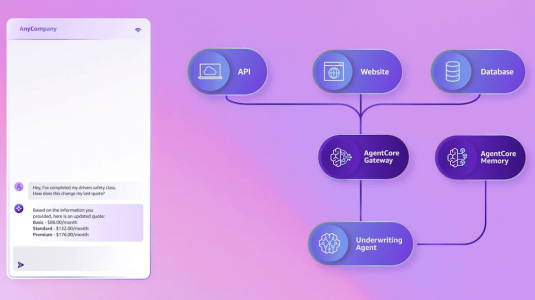Nearly ten years ago, in November 2012 at the first-ever Amazon Web Services (AWS) re:Invent, Andy Jassy, then AWS senior vice president, announced the preview of Amazon Redshift, the first fully managed, petabyte-scale cloud data warehouse. The service represented a significant leap forward from traditional on-premises data warehousing solutions, which were expensive, inflexible, and required significant human and capital resources to operate.
In a blog post on November 28, 2012, Werner Vogels, Amazon chief technical officer, highlighted the news: “Today, we are excited to announce the limited preview of Amazon Redshift, a fast and powerful, fully managed, petabyte-scale data warehouse service in the cloud.”
Further in the post, Vogels added, “The result of our focus on performance has been dramatic. Amazon.com’s data warehouse team has been piloting Amazon Redshift and comparing it to their on-premise data warehouse for a range of representative queries against a two billion row data set. They saw speedups ranging from 10x – 150x!”
That’s why, on the day of the announcement, Rahul Pathak, then a senior product manager, and the entire Amazon Redshift team were confident the product would be popular.
“But we didn’t really understand how popular,” he recalls.
“At preview we asked customers to sign up and give us some indication of their data volume and workloads,” Pathak, now vice president of Relational Engines at AWS, said. “Within about three days we realized that we had ten times more demand for Redshift than we had planned for the entire first year of the service. So we scrambled right after re:Invent to accelerate our hardware orders to ensure we had enough capacity on the ground for when the product became generally available in early 2013. If we hadn’t done that preview, we would have been caught short.”
The Redshift team has been sprinting to keep apace of customer demand ever since. Today, the service is used by tens of thousands of customers to process exabytes of data daily. In June a subset of the team will present the paper “Amazon Redshift re-invented ” at a leading international forum for database researchers, practitioners, and developers, the ACM SIGMOD/PODS Conference in Philadelphia.
The paper highlights four key areas where Amazon Redshift has evolved in the past decade, provides an overview of the system architecture, describes its high-performance transactional storage and compute layers, details how smart autonomics are provided, and discusses how AWS and Redshift make it easy for customers to use the best set of services to meet their needs.
Amazon Science recently connected with two of the paper’s authors, Pathak, and Ippokratis Pandis, an AWS senior principal engineer, to discuss the origins of Redshift, how the system has evolved over the past decade, and where they see the service evolving in the years ahead.
- Q.
Can you provide some background on the origin story for Redshift? What were customers seeking, and how did the initial version address those needs?
A.Rahul: We had been meeting with customers who in the years leading up to the launch of Amazon Redshift had moved just about every workload they had to the cloud except for their data warehouse. In many cases, it was the last thing they were running on premises, and they were still dealing with all of the challenges of on-premises data warehouses. They were expensive, had punitive licensing, were hard to scale, and customers couldn’t analyze all of their data. Customers told us they wanted to run data warehousing at scale in the cloud, that they didn’t want to compromise on performance or functionality, and that it had to be cost-effective enough for them to analyze all of their data.
So, this is what we started to build, operating under the code name Cookie Monster. This was at a time when customers’ data volumes were exploding, and not just from relational databases, but from a wide variety of sources. One of our early private beta customers tried it and the results came back so fast they thought the system was broken. It was about 10 to 20 times faster than what they had been using before. Another early customer was pretty unhappy with gaps in our early functionality. When I heard about their challenges, I got in touch, understood their feedback, and incorporated it into the service before we made it generally available in February 2013. This customer soon turned into one of our biggest advocates.
When we launched the service and announced our pricing at $1000 a terabyte per year, people just couldn’t believe we could offer a product with that much capability at such a low price point. The fact that you could provision a data warehouse in minutes instead of months also caught everyone’s attention. It was a real game-changer for this industry segment.
Ippokratis: I was at IBM Research at the time working on database technologies there, and we recognized that providing data warehousing as a cloud service was a game changer. It was disruptive. We were working with customers’ on-premises systems where it would take us several days or weeks to resolve an issue, whereas with a cloud data warehouse like Redshift, it would take minutes. It was also apparent that the rate of innovation would accelerate in the cloud.
In the on-premises world, it was taking months if not years to get new functionality into a software release, whereas in the cloud new capabilities could be introduced in weeks, without customers having to change a single line of code in their consuming applications. The Redshift announcement was an inflection point; I got really interested in the cloud, and cloud data warehouses, and eventually joined Amazon [Ippokratis joined the Redshift team as a principal engineer in Oct. 2015].
- Q.
How has Amazon Redshift evolved over the past decade since the launch nearly 10 years ago?
A.Ippokratis: As we highlight in the paper, the service has evolved at a rapid pace in response to customers’ needs. We focused on four main areas: 1) customers’ demand for high-performance execution of increasingly complex analytical queries; 2) our customers’ need to process more data and significantly increase the number of users who need to derive insights from that data; 3) customers’ need for us to make the system easier to use; and 4) our customers’ desire to integrate Redshift with other AWS services, and the AWS ecosystem. That’s a lot, so we’ll provide some examples across each dimension.
Offering the leading price performance has been our primary focus since Rahul first began working on what would become Redshift. From the beginning, the team has focused on making core query execution latency as low as possible so customers can run more workloads, issue more jobs into the system, and run their daily analysis. To do this, Redshift generates C++ code that is highly optimized and then sends it to the distributor in the parallel database and executes this highly optimized code. This makes Redshift unique in the way it executes queries, and it has always been the core of the service.
We have never stopped innovating here to deliver our customers the best possible performance. Another thing that’s been interesting to me is that in the traditional business intelligence (BI) world, you optimize your system for very long-running jobs. But as we observe the behavior of our customers in aggregate, what’s surprising is that 90 percent of our queries among the billions we run daily in our service execute in less than one second. That’s not what people had traditionally expected from a data warehouse, and that has changed the areas of the code that we optimize.
Rahul: As Ippokratis mentioned, the second area we focused on in the paper was customers’ need to process more data and to use that data to drive value throughout the organization. Analytics has always been super important, but eight or ten years ago it wasn’t necessarily mission critical for customers in the same way transactional databases were. That has definitely shifted. Today, core business processes rely on Redshift being highly available and performant. The biggest architectural change in the past decade in support of this goal was the introduction of Redshift Managed Storage, which allowed us to separate compute and storage, and focus a lot of innovation in each area.

The Redshift managed storage layer (RMS) is designed for a durability of 99.999999999% and 99.99% availability over a given year, across multiple availability zones. RMS manages both user data as well as transaction metadata. Another big trend has been the desire of customers to query across and integrate disparate datasets. Redshift was the first data warehouse in the cloud to query Amazon S3 data, that was with Redshift Spectrum in 2017. Then we demonstrated the ability to run a query that scanned an exabyte of data in S3 as well as data in the cluster. That was a game changer.
Customers like NASDAQ have used this extensively to query data that’s on local disk for the highest performance, but also take advantage of Redshift’s ability to integrate with the data lake and query their entire history of data with high performance. In addition to querying the data lake, integrated querying of transactional data stores like Aurora and RDS has been another big innovation, so customers can really have a high-performance analytics system that’s capable of transparently querying all of the data that matters to them without having to manage these complex integration processes that other systems require.

This diagram from the research paper illustrates how a query flows through Redshift. The sequence is described in detail on pages 2 and 3 of the paper. Ippokratis: The third area we focused on in the paper was ease of use. One change that stands out for me is that on-premises data warehousing required IT departments to have a DBA (data base administrator) who would be responsible for maintaining the environment. Over the past decade, the expectation from customers has evolved. Now, if you are offering data warehousing as a service, the systems must be capable of auto tuning, auto healing, and auto optimizing. This has become a big area of focus for us where we incorporate machine learning and automation into the system to make it easier to use, and to reduce the amount of involvement required of administrators.
Rahul: In terms of ease of use, three innovations come to mind. One is concurrency scaling. Similar to workload management, customers would previously have to manually tweak concurrency or reset clusters of the manually split workloads. Now, the system automatically provisions new resources and scales up and down without customers having to take any action. This is a great example of how Redshift has gotten much more dynamic and elastic.
The second ease of use innovation is automated table optimization. This is another place where the system is able to observe workloads and data layouts and automatically suggest how data should be sorted and distributed across nodes in the cluster. This is great because it’s a continuously learning system so workloads are never static in time.
Customers are always adding more datasets, and adding more users, so what was optimal yesterday might not be optimal tomorrow. Redshift observes this and modifies what's happening under the covers to balance that. This was the focus of a really interesting graph optimization paper that we wrote a few years ago about how to analyze for optimal distribution keys for how data is laid out within a multi-node parallel-processing system. We've coupled this with automated optimization and then table encoding. In an analytics system, how you compress data has a big impact because the less data you scan, the faster your queries go. Customers had to reason about this in the past. Now Redshift can automatically determine how to encode data correctly to deliver the best possible performance for the data and the workload.
The third innovation I want to highlight here is Amazon Redshift Serverless, which we launched in public preview at re:Invent last fall. Redshift Serverless removes all of the management of instances and clusters, so customers can focus on getting to insights from data faster and not spend time managing infrastructure. With Redshift Serverless, customers can simply provision an endpoint and begin to interact with their data, and Redshift Serverless will auto scale and automatically manage the system to essentially remove all of that complexity from customers.
Customers can just focus on their data, set limits to manage their budgets, and we deliver optimal performance between those limits. This is another massive step forward in terms of ease of use because it eliminates any operations for customers. The early response to the preview has been tremendous. Thousands of customers have been excited to put Amazon Redshift Serverless through its paces over the past few months, and we’re excited about making it generally available in the near future.

The Amazon Redshift architecture as presented in the research paper. Ippokratis: A fourth area of focus in the paper is on integration with other AWS services, and the AWS ecosystem. Integration is another area where customer behavior has evolved from traditional BI use cases. Today, cloud data warehouses are a central hub with tight integration with a broader set of AWS services. We provided the ability for customers to join data from the warehouse with the data lake. Then customers said they needed access to high-velocity business data in operational databases like Aurora and RDS, so we provided access to these operational data stores. Then we added support for streams, as well as integration with SageMaker and Lambda so customers can run machine learning training and inference without moving their data, and do generic compute. As a result, we’ve converted the traditional BI system into a well-integrated set of AWS services.
Rahul: One big area of integration has been with our machine-learning ecosystem. With Redshift ML we have enabled anyone who knows SQL to take advantage of all of our machine-learning innovation. We built the ability to create a model from the SQL prompt, which gets the data into Amazon S3 and calls Amazon SageMaker, to use automated machine learning to build the most appropriate model to provide predictions on the data.
This model is compiled efficiently and brought back into the data warehouse for customers to run very high-performance parallel inferences with no additional compute or no extra cost. The beauty of this integration is that every innovation we make within SageMaker means that Redshift ML gets better as well. This is just another means by which customers benefit from us connecting our services together.
Another big area for integration has been data sharing. Once we separated storage and compute layers with RA3 instances, we could enable data sharing, giving customers the ability to share data with clusters in the same account, and other accounts, or across regions. This allows us to separate consumers from producers of data, which enables things like modern data mesh architectures. Customers can share data without data copying, so they are transactionally consistent across accounts.
For example, users within a data-science organization can securely work from the shared data, as can users within the reporting or marketing organization. We’ve also integrated data sharing with AWS Data Exchange, so now customers can search for — and subscribe to — third-party datasets that are live, up to date, and can be queried immediately in Redshift. This has been another game changer from the perspective of setting data free, enabling data monetization for third-party providers, and secure and live data access and licensing for subscribers for high-performance analytics within and across organizations. The fact that Redshift is part of an incredibly rich data ecosystem is a huge win for customers, and in keeping with customers’ desire to make data more pervasively available across the company.
- Q.
You indicate in the paper that Redshift innovation is continuing at an accelerated pace. How do you see the cloud data warehouse segment evolving – and more specifically Redshift – over the next several years?
A.Rahul: A few things will continue to be true as we head into the future. Customers will be generating ever more amounts of data, and they’re going to want to analyze that data more cost effectively. Data volumes are growing exponentially, but obviously customers don't want their costs growing exponentially. This requires that we continue to innovate, and find new levels of performance to ensure that the cost of processing a unit of data continues to go down.
We’ll continue innovating in software, in hardware, in silicon, and in using machine learning to make sure we deliver on that promise for customers. We’ve delivered on that promise for the past 10 years, and we’ll focus on making sure we deliver on that promise into the future.
I’m very proud of what the team has accomplished, but equally as excited about all the things we’re going to do to improve Redshift in the future.
Ippokratis PandisAlso, customers are always going to want better availability, they’re always going to want their data to be secure, and they’re always going to want more integrations with more data sources, and we intend to continue to deliver on all of those. What will stay the same is our ability to offer the-best in-segment price performance and capabilities, and the best-in-segment integration and security because they will always deliver value for customers.
Ippokratis: It has been an incredible journey; we have been rebuilding the plane as we’ve been flying it with customers onboard, and this would not have happened without the support of AWS leadership, but most importantly the tremendous engineers, managers, and product people who have worked on the team.
As we did in the paper, I want to recognize the contributions of Nate Binkert and Britt Johnson, who have passed, but whose words of wisdom continue to guide us. We’ve taken data warehousing, what we learned from books in school (Ippokratis earned his PhD in electrical and computer engineering from Carnegie Mellon University) and brought it to the cloud. In the process, we’ve been able to innovate, and write new pages in the book. I’m very proud of what the team has accomplished, but equally as excited about all the things we’re going to do to improve Redshift in the future.























